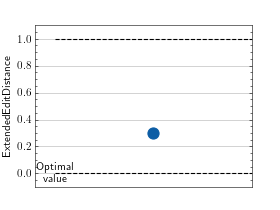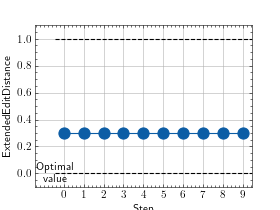Extended Edit Distance¶
Module Interface¶
- class torchmetrics.text.ExtendedEditDistance(language='en', return_sentence_level_score=False, alpha=2.0, rho=0.3, deletion=0.2, insertion=1.0, **kwargs)[source]¶
Compute extended edit distance score (ExtendedEditDistance) for strings or list of strings.
The metric utilises the Levenshtein distance and extends it by adding a jump operation.
As input to
forwardandupdatethe metric accepts the following input:preds(Sequence): An iterable of hypothesis corpustarget(Sequence): An iterable of iterables of reference corpus
As output of
forwardandcomputethe metric returns the following output:eed(Tensor): A tensor with the extended edit distance score
- Parameters:
language¶ (
Literal['en','ja']) – Language used in sentences. Only supports English (en) and Japanese (ja) for now.return_sentence_level_score¶ (
bool) – An indication of whether sentence-level EED score is to be returnedalpha¶ (
float) – optimal jump penalty, penalty for jumps between charactersrho¶ (
float) – coverage cost, penalty for repetition of charactersinsertion¶ (
float) – penalty for insertion or substitution of characterkwargs¶ (
Any) – Additional keyword arguments, see Advanced metric settings for more info.
Example
>>> from torchmetrics.text import ExtendedEditDistance >>> preds = ["this is the prediction", "here is an other sample"] >>> target = ["this is the reference", "here is another one"] >>> eed = ExtendedEditDistance() >>> eed(preds=preds, target=target) tensor(0.3078)
- plot(val=None, ax=None)[source]¶
Plot a single or multiple values from the metric.
- Parameters:
val¶ (
Union[Tensor,Sequence[Tensor],None]) – Either a single result from calling metric.forward or metric.compute or a list of these results. If no value is provided, will automatically call metric.compute and plot that result.ax¶ (
Optional[Axes]) – An matplotlib axis object. If provided will add plot to that axis
- Return type:
- Returns:
Figure and Axes object
- Raises:
ModuleNotFoundError – If matplotlib is not installed
>>> # Example plotting a single value >>> from torchmetrics.text import ExtendedEditDistance >>> metric = ExtendedEditDistance() >>> preds = ["this is the prediction", "there is an other sample"] >>> target = ["this is the reference", "there is another one"] >>> metric.update(preds, target) >>> fig_, ax_ = metric.plot()

>>> # Example plotting multiple values >>> from torchmetrics.text import ExtendedEditDistance >>> metric = ExtendedEditDistance() >>> preds = ["this is the prediction", "there is an other sample"] >>> target = ["this is the reference", "there is another one"] >>> values = [ ] >>> for _ in range(10): ... values.append(metric(preds, target)) >>> fig_, ax_ = metric.plot(values)

Functional Interface¶
- torchmetrics.functional.text.extended_edit_distance(preds, target, language='en', return_sentence_level_score=False, alpha=2.0, rho=0.3, deletion=0.2, insertion=1.0)[source]¶
Compute extended edit distance score (ExtendedEditDistance) [1] for strings or list of strings.
The metric utilises the Levenshtein distance and extends it by adding a jump operation.
- Parameters:
preds¶ (
Union[str,Sequence[str]]) – An iterable of hypothesis corpus.target¶ (
Sequence[Union[str,Sequence[str]]]) – An iterable of iterables of reference corpus.language¶ (
Literal['en','ja']) – Language used in sentences. Only supports English (en) and Japanese (ja) for now. Defaults to enreturn_sentence_level_score¶ (
bool) – An indication of whether sentence-level EED score is to be returned.alpha¶ (
float) – optimal jump penalty, penalty for jumps between charactersrho¶ (
float) – coverage cost, penalty for repetition of charactersinsertion¶ (
float) – penalty for insertion or substitution of character
- Return type:
- Returns:
Extended edit distance score as a tensor
Example
>>> from torchmetrics.functional.text import extended_edit_distance >>> preds = ["this is the prediction", "here is an other sample"] >>> target = ["this is the reference", "here is another one"] >>> extended_edit_distance(preds=preds, target=target) tensor(0.3078)
References
[1] P. Stanchev, W. Wang, and H. Ney, “EED: Extended Edit Distance Measure for Machine Translation”, submitted to WMT 2019. ExtendedEditDistance
